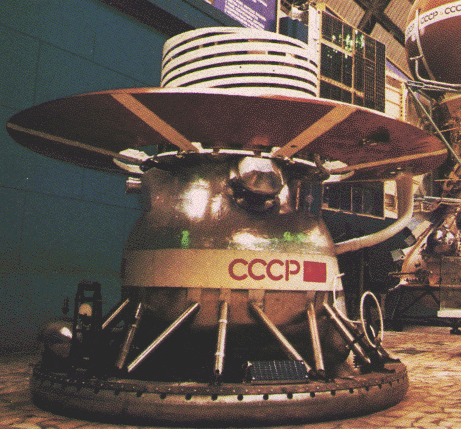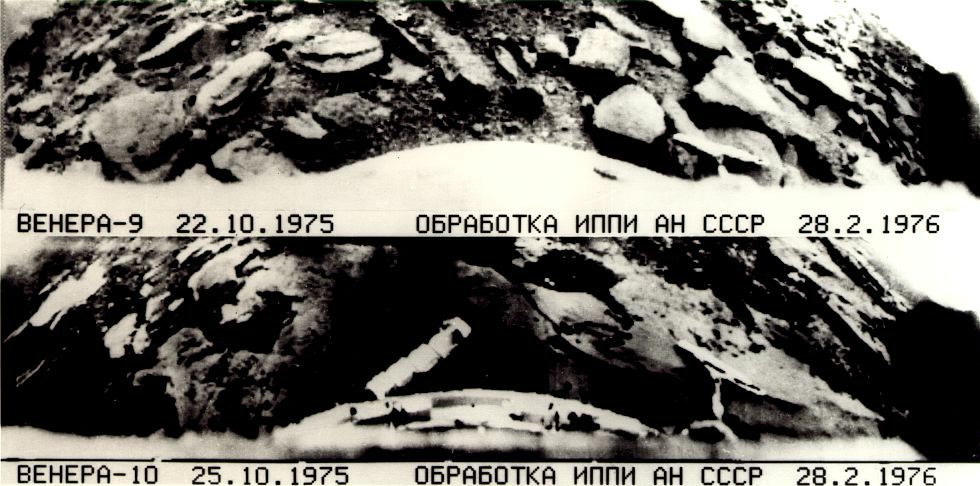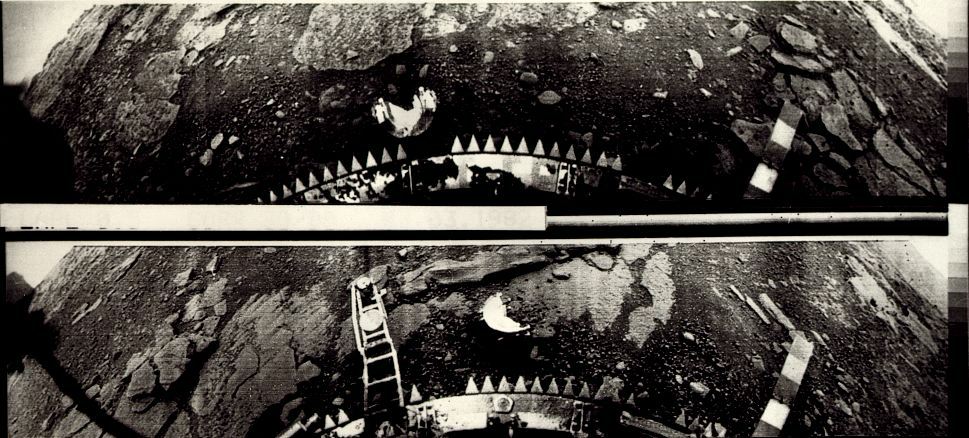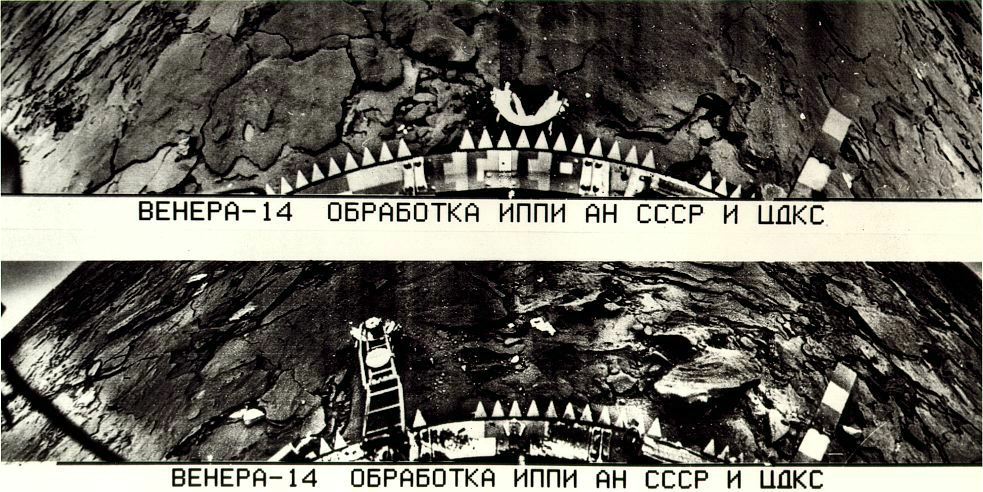
The Venera missions were a series of unmanned Soviet planetary probes that were sent to Venus. Venera 2 (launched in 1965) flew to within 25,000 miles (40,200 km) of Venus in February 1966, and Venera 3 crash-landed on its surface the following month, becoming the first spacecraft to strike another planet. Venera 4 (1967) analyzed the chemical composition of Venus' upper atmosphere and provided the scientific community with the first direct measurements for a model of the planet's atmospheric makeup. Venera 5 and 6 (1969) made similar soft landings on Venus, but ceased transmitting data before reaching the surface because of the extreme heat and pressure of the planet's atmosphere. Venera 7 (1970) and Venera 8 (1972) detected the occurrence of certain long-lived radioactive isotopes (chiefly uranium and thorium) on Venus' surface. Venera 9 and 10 (1975) sent back the first closeup photographs of the planet's surface; these images showed that certain parts of Venus were covered with sizable sharp-edged rocks and others with fine-grain dust. Venera 11 and 12 (1978) measured the chemical components of the planet's lower atmosphere.

The last lander was Venera 14, shown above. Venera 13 and 14 were identical spacecraft built to take advantage of the 1981 Venus launch opportunity and launched 5 days apart. The Venera 14 mission consisted of a bus (81-110A) and an attached descent craft (81-110D). The Venera 14 descent craft/lander was a hermetically sealed pressure vessel, which contained most of the instrumentation and electronics, mounted on a ring-shaped landing platform and topped by an antenna. The design was similar to the earlier Venera 9-12 landers. It carried instruments to take chemical and isotopic measurements, monitor the spectrum of scattered sunlight, and record electric discharges during its descent phase through the Venusian atmosphere. The spacecraft utilized a camera system, an X-ray fluorescence spectrometer, a screw drill and surface sampler, a dynamic penetrometer, and a seismometer to conduct investigations on the surface.
After launch and a four month cruise to Venus, the descent vehicle separated from the bus and plunged into the Venus atmosphere on 5 March 1982. After entering the atmosphere a parachute was deployed. At an altitude of about 50 km the parachute was released and simple airbraking was used the rest of the way to the surface. Venera 14 landed about 950 km southwest of Venera 13 near the eastern flank of Phoebe Regio at 13 deg 15 min S by 310 E on a basaltic plain. After landing an imaging panorama was started and a mechanical drilling arm reached to the surface and obtained a sample, which was deposited in a hermetically sealed chamber, maintained at 30 degrees C and a pressure of about .05 atmospheres. The composition of the sample was determined by the X-ray flourescence spectrometer, showing it to be similar to oceanic tholeiitic basalts. The lander survived for 57 minutes (the planned design life was 32 minutes) in an environment with a temperature of 465 degrees C and a pressure of 94 Earth atmospheres. The descent vehicle transmitted data to the bus, which acted as a data relay as it flew by Venus.

The Soviet Venera 9 and 10 spacecraft were launched on 8 and 14 June 1975, respectively, to do the unprecedented: place landers on the surface of Venus and return images. The Venera 9 Lander (top frame of above image) touched down on the surface of Venus on October 22, 1975 at 5:13 UT, about 32 S, 291 E with the sun near zenith. It operated for 53 minutes, allowing return of a single image. Venera 9 landed on a slope inclined by about 30 degrees to the horizontal. The white object at the bottom of the image is part of the lander. The distortion is caused by the Venera imaging system. Angular and partly weathered rocks, about 30 to 40 cm across, dominate the landscape, many partly buried in soil. The horizon is visible in the upper left and right corners.
The Venera 10 Lander (bottom frame of above image) touched down on the surface of Venus on October 25, 1975 at 5:17 UT, about 16 N, 291 E. The Lander was inclined about 8 degrees. It returned this image during the 65 minutes of operation on the surface. The sun was near zenith during this time, and the lighting was similar to that on Earth on an overcast summer day. The objects at the bottom of the image are parts of the spacecraft. The image shows flat slabs of rock, partly covered by fine-grained material, not unlike a volcanic area on Earth. The large slab in the foreground extends over 2 meters across.

On March 1, 1982 the Venera 13 lander touched down on the Venusian surface at 7.5 S, 303 E, east of Phoebe Regio. It was the first Venera mission to include a color TV camera. Venera 13 survived on the surface for 2 hours, 7 minutes, long enough to obtain 14 images. The above pictures were taken from its two opposite-facing cameras. The bottom frame shows the lander testing arm. The surface is made up of flat, platy rocks and soil. Parts of the lander and semi-circular lens covers can be seen in both images.

This color panorama was produced using dark blue, green and red filters and has a resolution of 4 to 5 min. Part of the spacecraft is seen at the bottom of the image. Flat rock slabs and soil are visible. The true color is difficult to judge because the Venerian atmosphere filters out blue light. The surface composition is similar to terrestrial basalt. On the ground in the foreground is a camera lens cover.

Venera 14 Lander images of the surface of Venus at 13 S, 310 E on 5 March 1982. The lander survived for 60 minutes. Both images show part of the lander at the bottom. This area is composed of flat basalt-like rocks, but little soil or fine-grained material as was seen at other Venera Lander sites. Near the center of the top image is a lens cover, and the bottom image shows a test arm.